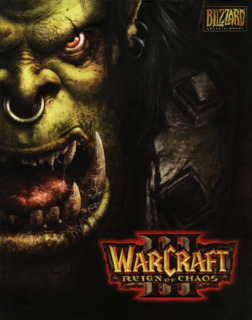One of the most profound and engrossing games to date.
Not long ago I was at the local video game proprietor when I came across this game, still on the shelves after so many years and still fetching $50 per copy. So, driven by nostalgia I inclined to buy it.
What I played was just how I remembered it, if not more.
Warcraft III, like it's predecessors, blends together fantasy with real-time strategy superbly; one minute you could be clearing a forest, the next slaying dragons or being overrun by zombies.
There are four playable factions: The Human Alliance, Orcish Horde, Night Elf Sentinels and Undead Scourge. Each faction brings with it unique units, buildings, upgrades and it's own separate campaign, not to mention it's own set of strengths and weaknesses.
Playing as the Alliance brings forth technological might such as gunpowder, as well as decent magics, but also expensive units and relatively slow building progress.
The Orcish Horde has brute strength on it's side and cool units, but again they're expensive and the buildings are the slowest to construct.
Night Elves are probably the most unique faction in the game as they don't have to destroy trees for lumber, certain buildings can walk around and attack
and the female units can turn invisible come nightfall. Many units are also inexpensive yet the Night Elves lack the strength of other races.
And last but not least are the Undead. Creatures that have died, been reassembled and reanimated make up the bulk of the undead armies. Boasting moderate strength, magic and cost, the true advantage of the Undead Scourge lies in numbers. Skeletons from downed enemies can be reanimated and supplemented into the armies to increase it's bulk.
Different strategies must be implemented when playing as or against each faction, simply sending tons of the strongest units available to clear a settlement just won't work, instead actual thinking must be done in order to figure out what unit counters what unit and ten of his friends and so forth.
Hero units are also introduced in Reign of Chaos, stronger than normal warriors and boasting a range of magics, each hero has its own inventory to store items boost his or her powers or aid allies. On top of that the hero can level up in combat, boosting power and upgrading its magic to make it a more formidable enemy. If killed, a hero unit can be revived at certain buildings at a cost and set time period, yet will still retain all its previous abilities and experience points.
The story starts off with the Orc warchief Thrall being visited in his dreams by an unnamed prophet. He his told to gather his people and cross the sea to the continent of Kalimdor in order to save them from an impending apocalypse. After a brief tutorial, Thrall rescues his people imprisoned by the humans and sets sail.
Meanwhile, Prince Arthas of the Alliance, one of the most promising paladins is tasked with investigating rumours of a death-cult and ensuing plague. He soon learns it is all orchestrated by a demon named Mal'Ganis who is using the plague to summon an army of the undead. The rest of the campaign follows Arthas' battle with the undead and ensuing madness which distances himself from his allies, even leading him to kill his own people. Pursuing Mal'Ganis to the frozen continent of Northrend, Arthas uses the cursed blade Frostmourne to slay the dreadlord, then abandons his men and disappears. Arthas reappears some time later to take control of the undead army and serve his mysterious new lord.
On the land of Kalimdor the Alliance and Orc survivors must ally themselves with the Night Elves who inhabit the land and fend off the undead army and defeat the evil they plan to unleash...
The story is incredibly engrossing, each character has their own backstory which intertwines with the others and results in a vibrant, rich universe that actually seems believable, the plot is incredibly fleshed out, linking to the storylines of previous games, yet it's not necessary to have played them in order to understand it. The dialogue is well scripted, voice acting is mostly excellent, units even make humorous remarks if selected repeatedly.
The soundtrack plays well with the game's content, if not necessarily memorable.
Graphically, the game does show it's age in all it's low resolution glory. However, the way the models are drawn seem more like an art form nowadays, semi-cartoonistic yet showing all the signs of the seriousness of the plot. The mid-campaign cutscenes on the other hand still hold up graphically even by today's standards, despite certain computers not registering them properly, however this only results in slight pixelation.
The multiplayer is one of the most refined aspects of the game. Utilising Blizzard's Battle.net service, players can compete online in tournaments or in standard vs mode, either on a team or free-for-all. However, included with the game is the world-editor software, the same software that the programmers used to actually make the game! In the hands of the players, many unique maps have been created, some are almost completely different games by their own right. Uploaded on Battle.net, these maps can be played by anyone across the globe which has lead to possibly one of the greatest online components in any game thus far.
Warcraft III: Reign of Chaos is the game that any self-respecting PC gamer, or for that matter, any gamer, must play at least once. The universe is just so well put together it would make a great fantasy novel (and probably has) and puts a terrific spin on the RTS genre. Please note I don't normally rate games 10/10 and I resent people who do, but this game is so well put together, incredibly fun and spawned such a behemoth of a franchise that it's easily one of the most influencial games in recent history.

